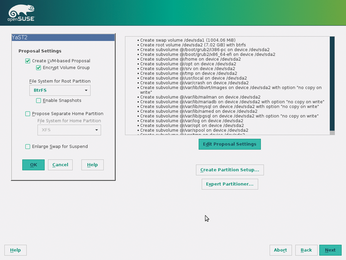Btrfs and the future of the filesystem
New Butter

The Btrfs filesystem offers advanced features such as RAID, subvolumes, snapshots, checksums, and transparent compression, but do desktop users really need all that power?
A filesystem functions below the operating system, ensuring that abstract data is converted into physical address attributes such as tracks and sectors. Some filesystems go beyond this basic functionality. One powerful and popular filesystem for Linux is Btrfs. The Btrfs filesystem [1], which is affectionately pronounced "ButterFS," is sometimes called the next generation filesystem. Btrfs is a copy-on-write filesystem [2] originally developed by Oracle Corporation and masterminded by Chris Mason. In some ways, Btrfs is best understood as an implementation of the Solaris 10 transactional filesystem ZFS [3] for the Linux platform. Oracle acquired ZFS in 2010 when it acquired Sun Microsystems. Btrfs is free software under the GPL and was adopted into Linux kernel 2.6.29 early in 2009.
Btrfs was declared suitable for production use in April 2013. Btrfs developer Chris Mason moved from SUSE, where he worked on ReiserFS, to Oracle, and he has worked at Facebook for several years, where Btrfs is widely used in the back end. Btrfs is now no longer limited to Linux; the WinBtrfs [4] project offers what are still experimental drivers for Windows. In the Linux world, Oracle started using Btrfs in its Unbreakable Linux release, version 2, four years ago, and SUSE in SUSE Linux Enterprise Server 12 (SLES 12) and openSUSE 13.2 (Figure 1). OpeSUSE Leap uses Btrfs as the default for the root partition; most other distributions include Btrfs in their archives and offer it as an alternative in the installer. Fedora plans to make Btrfs the default with Fedora 24.

[...]
Buy this article as PDF
(incl. VAT)
Buy Linux Magazine
Subscribe to our Linux Newsletters
Find Linux and Open Source Jobs
Subscribe to our ADMIN Newsletters
Support Our Work
Linux Magazine content is made possible with support from readers like you. Please consider contributing when you’ve found an article to be beneficial.

News
-
Zorin OS 18 Hits over a Million Downloads
If you doubt Linux isn't gaining popularity, you only have to look at Zorin OS's download numbers.
-
TUXEDO Computers Scraps Snapdragon X1E-Based Laptop
Due to issues with a Snapdragon CPU, TUXEDO Computers has cancelled its plans to release a laptop based on this elite hardware.
-
Debian Unleashes Debian Libre Live
Debian Libre Live keeps your machine free of proprietary software.
-
Valve Announces Pending Release of Steam Machine
Shout it to the heavens: Steam Machine, powered by Linux, is set to arrive in 2026.
-
Happy Birthday, ADMIN Magazine!
ADMIN is celebrating its 15th anniversary with issue #90.
-
Another Linux Malware Discovered
Russian hackers use Hyper-V to hide malware within Linux virtual machines.
-
TUXEDO Computers Announces a New InfinityBook
TUXEDO Computers is at it again with a new InfinityBook that will meet your professional and gaming needs.
-
SUSE Dives into the Agentic AI Pool
SUSE becomes the first open source company to adopt agentic AI with SUSE Enterprise Linux 16.
-
Linux Now Runs Most Windows Games
The latest data shows that nearly 90 percent of Windows games can be played on Linux.
-
Fedora 43 Has Finally Landed
The Fedora Linux developers have announced their latest release, Fedora 43.

